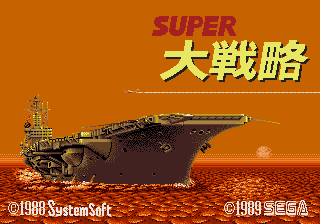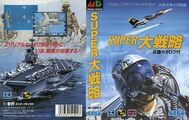Difference between revisions of "Super Daisenryaku"
From Sega Retro
m |
Pobert-Eii (talk | contribs) m |
||
| Line 22: | Line 22: | ||
}} | }} | ||
}} | }} | ||
| − | {{sub-stub}}'''''{{PAGENAME}}''''' (スーパー大戦略) is a 1988 World War II simulation game for NEC's PC-88 and PC-98 computers by [[SystemSoft]] in their ''Daisenryaku'' series of WWII sims. [[Sega]] ported it to the [[Sega Mega Drive]] in 1989, putting in a new soundtrack | + | {{sub-stub}}'''''{{PAGENAME}}''''' (スーパー大戦略) is a 1988 World War II simulation game for NEC's PC-88 and PC-98 computers by [[SystemSoft]] in their ''Daisenryaku'' series of WWII sims. [[Sega]] ported it to the [[Sega Mega Drive]] in 1989, putting in a new soundtrack composed by [[Tokuhiko Uwabo]]. Not only was it never released outside Japan, but it does not fully implement [[TMSS]], meaning it will only work on early Model 1 Mega Drives. |
The Mega Drive would receive a sequel, ''[[Advanced Daisenryaku]]'', which not only does work on all Mega Drives, but also contained [[Mega Modem]] support. | The Mega Drive would receive a sequel, ''[[Advanced Daisenryaku]]'', which not only does work on all Mega Drives, but also contained [[Mega Modem]] support. | ||
Revision as of 00:20, 25 November 2022
| Super Daisenryaku | ||||||||||
|---|---|---|---|---|---|---|---|---|---|---|
| System(s): Sega Mega Drive | ||||||||||
| Publisher: Sega | ||||||||||
| Developer: Sega R&D 2 | ||||||||||
| Licensor: SystemSoft | ||||||||||
| Original system(s): JP Home Computers | ||||||||||
| Developer(s) of original games: SystemSoft | ||||||||||
| Genre: Simulation[1][2] | ||||||||||
| Number of players: 1-4 | ||||||||||
| ||||||||||
|
This teeny-tiny article needs some work. You can help us by expanding it.
Super Daisenryaku (スーパー大戦略) is a 1988 World War II simulation game for NEC's PC-88 and PC-98 computers by SystemSoft in their Daisenryaku series of WWII sims. Sega ported it to the Sega Mega Drive in 1989, putting in a new soundtrack composed by Tokuhiko Uwabo. Not only was it never released outside Japan, but it does not fully implement TMSS, meaning it will only work on early Model 1 Mega Drives.
The Mega Drive would receive a sequel, Advanced Daisenryaku, which not only does work on all Mega Drives, but also contained Mega Modem support.
Contents
Production credits
Magazine articles
- Main article: Super Daisenryaku/Magazine articles.
Promotional material
Print advert in Beep! MegaDrive (JP) #0: "Extra issue of Beep!" (1989-04-27)
Physical scans
| Sega Retro Average | |||||||||||||||||||||||||||||||||||||||
|---|---|---|---|---|---|---|---|---|---|---|---|---|---|---|---|---|---|---|---|---|---|---|---|---|---|---|---|---|---|---|---|---|---|---|---|---|---|---|---|
|
| 77 | |
|---|---|
| Based on 7 reviews | |
References
NEC Retro has more information related to Super Daisenryaku
|
- ↑ File:SuperDaisenryaku MD JP Box.jpg
- ↑ 2.0 2.1 https://sega.jp/history/hard/megadrive/software.html (Wayback Machine: 2020-07-20 09:51)
- ↑ 1700 igr dlya Sega, "" (RU; 2001-xx-xx), page 83
- ↑ Beep! MegaDrive, "February 1990" (JP; 1990-01-08), page 72
- ↑ Console XS, "June/July 1992" (UK; 1992-04-23), page 134
- ↑ Mega Drive Fan, "November 1989" (JP; 1989-10-07), page 49
- ↑ Sega Pro, "April 1992" (UK; 1992-03-19), page 30
- ↑ Sega Pro, "April 1993" (UK; 1993-03-11), page 68
- ↑ Sega Saturn Magazine, "September 1995" (JP; 1995-08-08), page 85





